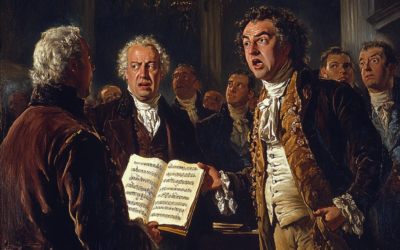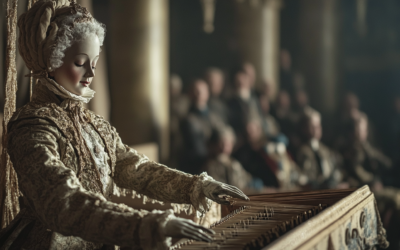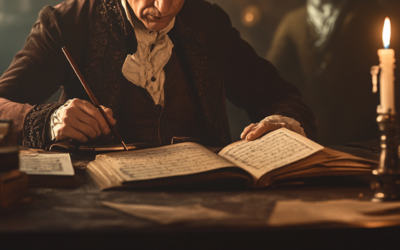The Rattling Symphony
A Critical Take on K. 17
Often attributed to Mozart, the K. 17 symphony is anything but refined. Lacking orchestration and filled with gaps, it raises more questions than answers about its true authorship.
Mozart: The Fall of the Gods
This book compiles the results of our studies on 18th-century music and Mozart, who has been revered for over two centuries as a deity. We dismantle the baseless cult of Mozart and strip away the clichés that falsely present him as a natural genius, revealing the contradictions in conventional biographies. In this work, divided into two parts, we identify and critically analyze several contradictory points in the vast Mozart bibliography. Each of the nearly 2,000 citations is meticulously sourced, allowing readers to verify the findings. This critical biography of Mozart emerges from these premises, addressing the numerous doubts raised by researchers.
"When gaps, borrowings, and inconsistencies are overlooked, even a shoddy piece can be glorified as a stroke of genius."
Mozart: The Fall of the Gods
Symphony K. 17 No. 2 in B-flat Major
Can a symphony be described as “rattling”? Indeed, sometimes it can. Such is the case with K. 17, a piece that was long attributed to Wolfgang Amadeus Mozart, only to later be unmasked as a spurious work. This is Symphony K. 17 No. 2 in B-flat Major, according to the Köchel catalogue.
Movements
- Allegro (B-flat Major)
- Andante (E-flat Major)
- Minuet I (B-flat Major)
- Minuet II (E-flat Major)
- Presto (B-flat Major)
Attribution to Johann Sebastian Bach? The K. 17 No. 2 symphony was not written by Wolfgang; it’s a counterfeit, its true author unknown. When critics can’t precisely determine if a piece is by Wolfgang, they often attribute it to dear old Leopold. Even today, one might still read that “the attribution is uncertain, possibly by Leopold Mozart.” Gherardo Casaglia, on page 24 of his catalogue, writes that it is “doubtful, attributed to Leopold Mozart (or Johann Sebastian Bach)!” A name can indeed become a sort of guarantee – for commercial purposes, at least.
Doubts If the authorship is uncertain, and it’s certainly not by Johann Sebastian Bach or Mozart the son, there’s no reason it must be by Mozart the father either. Even if the Andantino theme, when transposed from E-flat to F, does appear in Leopold’s Violinschule. Given the number of themes Leopold pilfered, it’s equally plausible that the true composer was someone else entirely. Massimo Mila noted an archaic and provincial quality in this piece, reflecting a rather antiquated view of the German symphony. Della Croce similarly highlights these stylistic archaisms, mirroring the critiques by Wyzewa and De Saint-Foix. But, even in Mila and Della Croce’s time, it was already known that the work was not by Wolfgang.
Certainties Those who didn’t suspect K. 17 was spurious, like Wyzewa and De Saint-Foix, defended its questionable quality in various ways:
“Chelsea, between July and September 1764. The autograph of this symphony, which Köchel saw in 1860 in the André collection, carries no date of composition. But some suspect it might be even earlier, considering that it was left incomplete, bearing in mind the quality of contemporary works. Not only is it somewhat rougher and musically poorer, but without a doubt, it represents a symphonic model that Mozart would abandon completely after his stay in London, under the influence of Italian composers and Johann Christian Bach. He would then adopt a new symphonic style, which he would consistently retain until his 1768 Vienna journey.
Let us mention some peculiarities of this Symphony. Immediately, it’s clear that young Mozart was not yet capable of orchestrating. In the first movement, he forgot to write parts for the winds… In the Andante, the second violin and viola parts are left blank after 5 or 6 measures. In the Finale, he leaves the opening four bars of the oboe and horn parts completely empty. The second Minuet is the only movement written in full, though even here, the winds are absent. As for the first Minuet, Mozart quickly tired of notating both the first violin and bass lines – or perhaps, as one might suspect, he copied an old harpsichord minuet, intending to orchestrate it later.”
Illustrious Commentaries It is enlightening to read how, in speaking of Mozart, even a monstrosity like this piece is somehow spun as a product of genius, despite its gaps, borrowings, and glaring absurdities:
“The Finale is the only movement where Mozart’s genius might be glimpsed. It’s a lively, well-paced piece with neatly assembled ideas. The echo effects reveal his early attempts at contrasting the violins and basses. Indeed, the work of a novice. And one can only be amazed at how quickly Mozart would soon master all the secrets of a style and genre that only now presents itself to him for the first time.”
— Wyzewa and De Saint-Foix
Curious and Entertaining Questions If Mozart wasn’t capable of writing the rattling K. 17, who, one wonders, composed the K. 16?
You May Also Like
When the Myth Collapsed
Vienna exposed the myth: La Finta semplice was riddled with errors, and Wolfgang’s supposed opera genius was nothing more than Leopold’s fabrication. With their reputation in ruins, father and son turned to Italy, hoping to rewrite history.
The London Notebook and the Vienna Disaster
Far from the myth of a flawless young genius, Mozart’s London Notebook reveals musical struggles and guided exercises, while the Vienna opera disaster proved that his father played a far greater role in his compositions than legend would have us believe.
Versailles, Vanity, and the Pursuit of Prestige
Leopold Mozart’s letters transformed his son’s European tour into a carefully staged fantasy—filled with exaggerated encounters, fabricated royal admiration, and a relentless pursuit of social prestige. But how much of it was real?
The Fabricated Childhood of Mozart
The legend of young Mozart’s divine genius crumbles under scrutiny, revealing a childhood dictated by Leopold’s ambition, carefully constructed myths, and a relentless pursuit of fame at the expense of genuine artistic education.
The Man Behind the Myth
Leopold Mozart’s legacy has been shaped by myths and hagiographies, but his letters reveal a man more concerned with financial gain and self-promotion than artistic integrity. Was he truly a devoted father, or simply an opportunist?
Constanze vs. The Catholic Church
For over two centuries, scholars have debated the circumstances surrounding Mozart’s burial. Constanze Mozart’s supposed inability to mark his grave, the confrontation with the Catholic Church over funeral masses, and the baffling disappearance of Mozart’s body all contribute to a mystery stranger than fiction. Did a powerful group keep her silent? And what really happened to Mozart’s remains?







